Perennial Solutions: Monarda Didyma Balmy Series
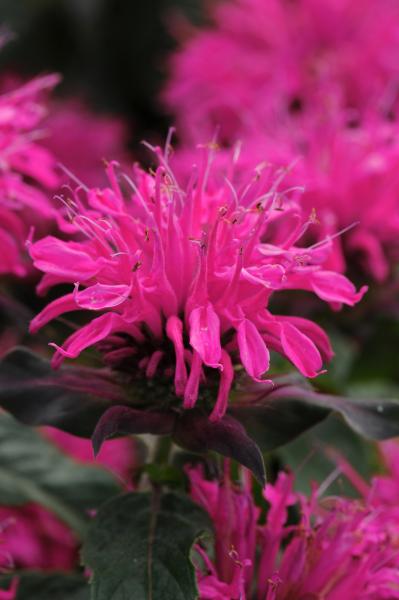 In recent years, breeders have been working diligently to improve the attributes of bee balm. The monarda Balmy series is a great example of these efforts. The Balmy series is compact, has very mildew resistant foliage and produces an abundance of bold-colored flowers. There are currently four colors in the Balmy series: Lilac (light purple), Pink (vivid pink), Purple (purple-red) and Rose (rosy-pink).
In recent years, breeders have been working diligently to improve the attributes of bee balm. The monarda Balmy series is a great example of these efforts. The Balmy series is compact, has very mildew resistant foliage and produces an abundance of bold-colored flowers. There are currently four colors in the Balmy series: Lilac (light purple), Pink (vivid pink), Purple (purple-red) and Rose (rosy-pink).
The Balmy cultivars are considerably shorter than many of the traditional cultivars in production today; they only grow 10-12 inches tall. With their dark green, lance-shaped, fragrant foliage, the plants are attractive even when they are not blooming. The colorful, shaggy flower heads open in the early summer and are great at attracting pollinators including bees, butterflies and hummingbirds into the garden. While they are pollinator friendly, rabbits and deer tend to stay away.
Bee balm performs well in sunny locations with moist, but not wet, soil conditions. They can be grown throughout USDA Hardiness Zones 4 to 9. These native North American perennials make great additions to perennial borders or when used in mass plantings. They also make excellent cut flowers and container plants.
If you’re looking for eye-catching, summer flowering perennials, which attract pollinators and offer strong landscape performance, consider the monarda Balmy series.
Propagation
Monarda Balmy is vegetatively propagated using tip cuttings. Plant patents for these cultivars are being sought (PPAF-Plant Patent Applied For); unlicensed propagation of this series is prohibited. However, unrooted cuttings (URCs) are available for propagators to purchase.
If possible, stick the cuttings the day they are received. Otherwise, the cuttings can be stored at 45° F for no more than one day. Stick the cuttings into a pre-moistened, well-drained propagation substrate. To improve survival during the winter months (in liners or containers), it is best to stick the cuttings so one node is below the surface of the propagation mix. The cuttings can be treated with 500-ppm IBA to improve the uniformity of rooting.
Place the cuttings under moderate to high mist levels for the first 24-48 hours to decrease stress and rehydrate the cuttings. After this period, the mist levels can be reduced to low levels for the next seven to ten days. Begin fertilization with 75- to 100-ppm nitrogen five to seven days after the cuttings are stuck. Throughout the propagation period, the soil temperatures should be maintained at 70-72° F to optimize root development.
The misting can gradually be reduced, slightly more each day and removed altogether when the leaves begin to expand and roots are present (between day 12 and 16). Increase the frequency of the fertilizer applications as the plants develop roots. It is recommended to pinch the liners at 21-25 days after sticking to promote branching. The liners are usually ready to be shipped or transplanted at 28-35 days after sticking.
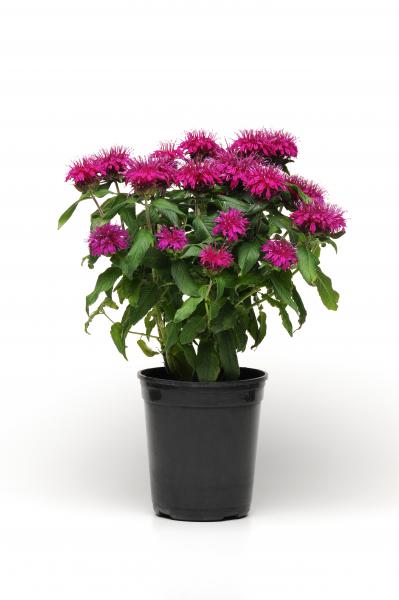
Balmy monarda are considerably shorter than many of the traditional cultivars in production today.
Production
The Balmy series is suitable for production in 1-quart to 1-gallon sized containers. Monarda perform best when they are grown in a moist, well-drained growing mix. After potting, the original soil line of the liner should be even with the surface of the growing medium of the new container.
Maintain the media throughout the production cycle with a pH between 5.8 and 6.2. They require moderate amounts of fertility. Nutrients can be delivered using water-soluble fertilizers with rates of 125- to 150-ppm nitrogen with each irrigation or 200-50 ppm at every other watering. Nutrients can also be delivered using controlled-release fertilizers by top-dressing using the medium recommended rate on the fertilizer label or incorporating into the growing medium prior to planting using a rate equivalent to 1.0 to 1.2 pounds of elemental nitrogen per yard of growing mix.
Bee balm requires average amounts of irrigation; they should be kept at moderate to moist moisture levels during production. The plants should not be kept saturated or allowed to wilt at any time. Water them thoroughly when irrigation is necessary and allow them to dry slightly between waterings. The highest quality plants are produced in high light environments (minimum 5,000 foot-candles).
They can be pinched during production if more branching and fullness is desired. Pinching is best done in the spring before the day lengths become long enough to promote flowering (14 hours); pinching under naturally short day lengths effectively promotes lateral branching and does not delay the time to flower.
With its compact habit, it is usually not necessary to control plant height when producing the Balmy series. Even when growing at high plant densities, height control is often not required. If the plants need to be toned, spray applications of 2,500-ppm daminozide (B-Nine or Dazide) are effective.
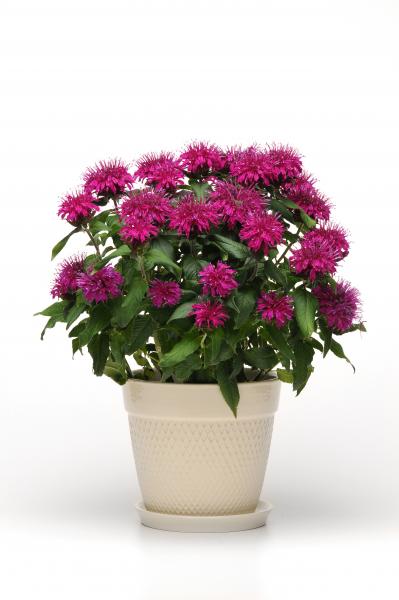
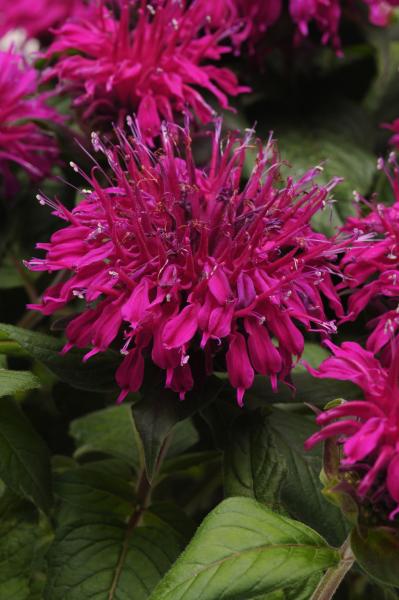 The Balmy series is suitable for production in 1-quart to 1-gallon sized containers.
The Balmy series is suitable for production in 1-quart to 1-gallon sized containers.
Insects and Diseases
A few insects and diseases may be observed on monarda during production. The most common insect pests are aphids, spider mites, thrips and whiteflies. Growers may also see caterpillars, grasshoppers, leafhoppers and slugs on occasion. The Balmy series is very resistant to powdery mildew, which is the most common disease of monarda; however, under the right circumstances (namely high humidity with poor circulation) this disease can still occur. Other pathogens known to infect bee balm include Cercospora leaf spot, crown and root rots (Pythium and Rhizoctonia) and rust. Growers should utilize routine scouting programs to detect the presence of insects and diseases early, and to determine if and when control strategies are necessary.
Scheduling and Temperature
With its early flowering, the Balmy series can be easily grown in bloom for sales from the late spring and throughout the summer months.
For large containers sizes or to produce fuller plants, many growers grow monarda as a traditional perennial; planting them in the late summer the year before they are to be marketed. The second method entails planting large liners or multiple liners in the spring; plant one liner per 1-quart container, one to two liners per 1-gallon pot and three plants per pot for 2-gallon or larger sized containers.
Monarda do not require vernalization for flowering, but are classified as cold beneficial perennials as they will flower a couple of weeks faster when the plants have been vernalized. They require long day lengths for the best flowering (facultative long day plant). When the day lengths are naturally short (less than 14 hours), provide photoperiodic lighting, creating long day lengths with day extension or night interruption lighting when earlier flowering is desired.
The time to bloom after vernalization and the proper photoperiod provided is a function of temperature. When the Balmy series are grown at 60-65° F under long day lengths, they will flower in approximately 10 weeks; non-vernalized plants will take a couple of weeks longer to bloom.
Availability
Monarda Balmy series is brought to the market by Darwin Plants (www.darwinplants.com). Unrooted cuttings are available from the Ball Horticultural Company (www.ballhort.com). Rooted liners can also be obtained from Ball Horticultural Company and other reputable perennial propagators.
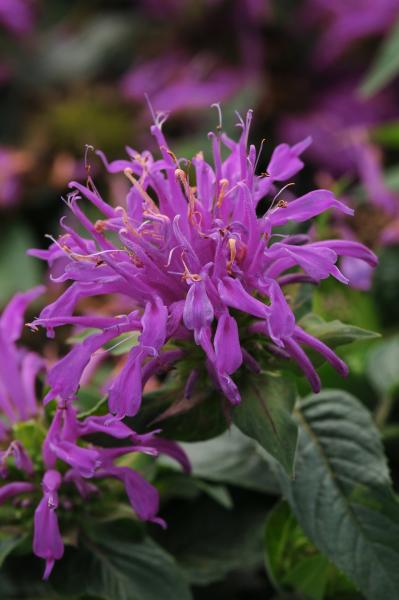 Balmy monarda makes an excellent cut flower and container plant.
Balmy monarda makes an excellent cut flower and container plant.


 Video Library
Video Library 




















